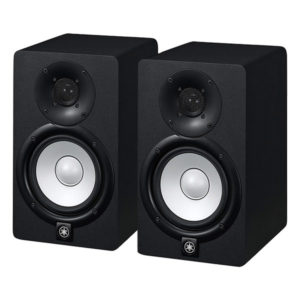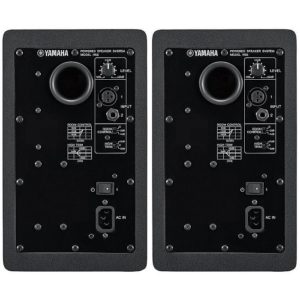Yamaha HS5 powered studio monitors product breakdown
Specifications:
- 2-Way bass-reflex bi-amplified nearfield studio monitor with 5″ cone woofer and 1″ dome tweeter
- 54Hz-30kHz frequency response
- 45W LF plus 25W HF bi-amp system for high-performance 70W power amplification
- Room Control and High TRIM response controls
- XLR and TRS phone jack inputs accept balanced or unbalanced signals
Key Features
- 5″, 7″, and 8″ models
- Room control switches
- A staple for many small studios
- Awesome, well known black design, also comes in white
Preferred Usage
- Studio mixing and monitoring
- Making instrumentals
- Small house parties and events
Pros:
- High quality sound output
- Wide frequency range
- Room controls
- XLR and TRS inputs
Cons:
- Requires several accessory purchases for proper usage such as:
- Sound interface with at least 2 inputs
- Connection cables
- Foam isolation pads
- Monitor stands
Full review: Yamaha HS5 powered studio monitors
It goes without saying that Yamaha is a trusted and well known brand across several markets, and one of them just happens to be studio monitors. The Yamaha HS series of studio monitors takes the cake as the best value for money when it comes to wide frequency response sound quality for mixing and monitoring your music! You won’t want to go back to any other studio monitors after using the Yamaha HS studio monitors for a few days.
I’ve personally used the Yamaha HS5 and HS8 monitors for many years and I cannot recommend a better product in the price range of $150-$350 for a single monitor. If you want a bundle deal (which I recommend), you can save close to $100 when buying a pair of monitors, stands, and cables directly from the Yamaha store on Amazon. All you need next is a quality USB sound interface with two line inputs, and then you’re powered up and ready to jam some crispy music.
The Yamaha HS powered monitors have incredible sound quality
The first thing you’ll notice about the Yamaha studio monitors is that they are designed with the upstanding image Yamaha has carried with them throughout their brand lineage. The design of the HS monitors is very appealing and will blend in well with any studio set up. The second thing you’ll notice after you have everything set up and start working on your first project is that the Yamaha monitors have an incredible sound quality which separates them from any other studio monitors on the market. The deep lows, sweet mids and crispy highs will keep you coming back for more and perfecting your mix for hours on end.
The Yamaha HS powered studio monitors fit all sizes!
Offered in black or white (I prefer black because it looks way cooler), the Yamaha monitors come in three different sizes to suit your needs: 5″, 7″, and a large 8″ size. I have not personally used the 7″ size, but I can say from experience that the 8″ Yamaha monitor is incredibly loud and powerful. The HS5″ monitors have very crispy highs and mids, but the lows are lacking in comparison to the 8″ big boy size. If you have the budget and space, I recommend grabbing the 8″ Yamaha monitors instead of a smaller size, as you will definitely appreciate the low frequency bass response more.
Many engineers like to add the cherry on top of the cake with the Yamaha HS8 studio subwoofer. Be prepared to shell out another $400-500 for this subwoofer, and also be prepared to have a few heated talks with your neighbors because the bass is insanely loud. The subwoofer is incredibly loud and house-shaking. If you opt for the Yamaha HS8 studio monitors, the bass response is good enough that you will probably not even need the additional $500 subwoofer unless you’re just a bass fanatic and don’t have neighbors, however, if you opt for the smaller HS5 monitors, you should probably consider getting the subwoofer as a bass frequency supplement because the HS5 lacks in bass response compared to the larger sized monitors.
Technical specifications about the Yamaha HS studio monitors
The HS monitors have two separate input jacks on the back to connect to your audio interface, and they are powered by generic wall outlets or a surge protector (recommended). The monitors offer a power switch on the back which comes in handy if you are OCD about your equipment like I am. I don’t turn my monitors on until my computer and software is fully loaded up. You also might want to make a habit out of turning your monitors on and off via the power switches on the back when not in use to prolong their life.
A really cool feature about the HS monitors is the ability to switch room control to -2db or -4db to optimize your mixing environment. This feature cuts off lower end frequencies around 500hz which can help improve your mixes based on your studio environment. A second switch offers the ability to trim higher frequencies above the 2khz frequency range and can be especially beneficial when mixing higher frequency sounds. Finally, you get a volume knob which can control your volume input into your sound interface on a level from 1-10. I recommend that you don’t turn the volume all the way up to 10 as it can put unnecessary strain on the monitors and shorten the life. Mixing at volume 10 is also not recommended unless you want to damage your hearing. I usually keep my volume level from 5-7.5 and control the master gain through my sound interface.
Typical applications for the Yamaha HS studio monitors
Whether you’re a home studio enthusiast or you just like extra clear and crisp high quality sound for your music listening pleasure, the Yamaha HS monitors are an amazing experience. Most average music listeners don’t want to fork out $800 for a monitor bundle, but if you do, you won’t regret it. If you’re in a project home studio or a big budget baller studio, the HS monitor line is a well known staple of the music industry and will always receive compliments from visitors. Most engineers love the HS studio monitors and I couldn’t tell you how many times I’ve been asked if I wanted to sell my monitor setup when people come to visit.
Durability and longevity of the Yamaha HS studio monitors
The only consideration I have about the Yamaha studio monitors is durability. I had one HS5 monitor blow on me after about 3 years of usage and my warranty was expired. I didn’t hesitate to go buy another HS5 from Guitar Center when they were on sale for $150 each, so that alone should tell you how much I love them. I’ve used my monitors for studio mixing and even DJ’d some live parties with them from time to time, so I could have overpowered them through my DJ unit and put unnecessary stress on the monitor. I’ve only had one Yamaha monitor blow on me throughout my years using their products, and I’ve pushed them incredibly hard over the years, so I wouldn’t call this a deal breaker at all. I would just advise users to be careful not to crank the volume gain knobs up to 10 right after powering on the units — give these puppies some time to warm up and break them in properly.
Should you buy the Yamaha HS studio monitors?
If you’re in the market for a budget monitor setup, I’d absolutely recommend grabbing a pair of the Yamaha HS monitors and you’ll never regret it. If you’re lucky, you can find a sweet deal at Guitar Center on Yamaha monitors, otherwise, I recommend grabbing this Yamaha HS Studio Monitor bundle which comes with 2 monitors, cables, and stands.
Another thing you might want to consider is Auralex’s foam isolation pads which the monitors stand on top of to reduce vibration and unnecessary noise from the monitor stands. After that, you’ll absolutely need a USB (or other) sound interface with at least 2 inputs if you’re not using a subwoofer, and at least 3 inputs if you are using a subwoofer.


